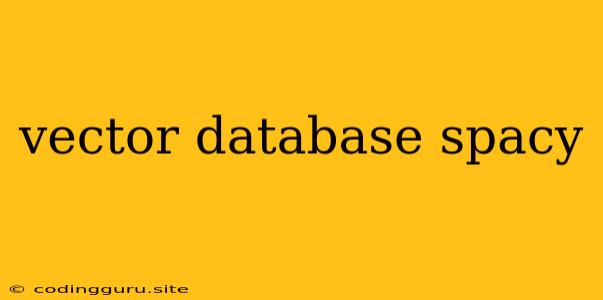Embracing the Power of Vector Databases with spaCy: A Comprehensive Guide
In the realm of natural language processing (NLP), extracting meaningful information from text is a fundamental task. But what happens when you need to search and retrieve information based on the semantic similarity of text, not just exact matches? This is where vector databases and powerful NLP libraries like spaCy come into play.
What is a Vector Database?
A vector database is a specialized database designed to store and query data represented as vectors. Vectors are mathematical representations of data points in a multi-dimensional space. These vectors capture the semantic meaning of text, allowing you to perform similarity searches based on the underlying meaning of the words, rather than just matching keywords.
Why Use a Vector Database with spaCy?
spaCy is a popular open-source NLP library known for its efficiency and ease of use. It provides tools for tokenization, part-of-speech tagging, named entity recognition, and more. Combining spaCy with a vector database unlocks a range of powerful capabilities:
- Semantic Search: Instead of searching for documents that contain specific words, you can search for documents that are semantically similar to a given query. This allows you to find relevant information even if your query uses different words than the documents themselves.
- Recommendation Systems: By understanding the semantic relationships between documents, you can build recommendation systems that suggest relevant content to users based on their interests or past interactions.
- Clustering and Categorization: Group similar documents together based on their meaning, even if they don't share the same keywords. This can be valuable for organizing large amounts of data or for identifying topics and trends.
- Question Answering: Develop systems that can understand the meaning of questions and retrieve answers from a corpus of text.
How Does it Work?
The magic happens when you combine spaCy's ability to extract meaningful information from text with the power of vector databases. Here's a simplified explanation:
- Text Preprocessing: spaCy tokenizes and processes your text data, removing punctuation and stop words.
- Embeddings: spaCy generates vector representations of your text. These vectors capture the semantic meaning of words and phrases.
- Vector Database Storage: The vectors are stored in a vector database, where they can be efficiently searched and compared.
- Semantic Similarity Search: When you have a query, you generate its vector representation using spaCy. The vector database then finds the vectors that are most similar to the query vector, returning the corresponding documents.
Choosing the Right Vector Database
Several vector databases are available, each with its strengths and weaknesses. Some popular options include:
- Pinecone: A scalable and managed vector database specifically designed for NLP applications.
- Milvus: An open-source vector database known for its high performance and flexibility.
- Faiss: A library from Facebook that provides efficient similarity search algorithms for large datasets.
The best choice for you will depend on factors like your dataset size, performance requirements, and budget.
Getting Started
To get started with vector databases and spaCy, you'll need to choose a vector database, install the necessary libraries, and then write code to:
- Load your text data.
- Process the data with spaCy to generate embeddings.
- Store the embeddings in the vector database.
- Write code to query the vector database using your search terms.
Tips and Tricks
- Experiment with Different Embeddings: spaCy offers various embedding models. Experiment with different models to find the one that best captures the semantics of your data.
- Optimize Query Performance: Vector databases often have optimization settings that can improve search speed. Experiment with these settings to fine-tune your searches.
- Leverage Pre-trained Models: spaCy provides pre-trained models for different languages and domains. Using a pre-trained model can save you time and effort in training your own models.
Example Code
Here's a basic example using spaCy and Pinecone to perform semantic search:
import spacy
import pinecone
# Load your spaCy model
nlp = spacy.load("en_core_web_md")
# Connect to your Pinecone index
pinecone.init(api_key="YOUR_API_KEY", environment="YOUR_ENVIRONMENT")
index_name = "my-index"
pinecone.create_index(index_name, dimension=300, metric="cosine")
# Process your text data and store embeddings in Pinecone
for text in your_text_data:
doc = nlp(text)
embedding = doc.vector
pinecone.upsert(index_name, [{"id": text, "values": embedding.tolist()}], upsert_kwargs={"vectors": [{"id": text, "values": embedding.tolist()}]})
# Query the vector database using a search term
search_term = "artificial intelligence"
query_vector = nlp(search_term).vector
# Find the most similar documents
results = pinecone.query(index_name, top_k=10, vector=query_vector.tolist())
# Print the results
for result in results['matches']:
print(result['id'], result['score'])
Conclusion
Vector databases and spaCy offer a powerful combination for performing semantic search, building recommendation systems, and extracting meaning from text. By leveraging the semantic power of vectors, you can unlock new capabilities in your NLP applications. As the field of NLP continues to evolve, the integration of vector databases and tools like spaCy will play an increasingly important role in making sense of the vast amount of textual data available to us.
